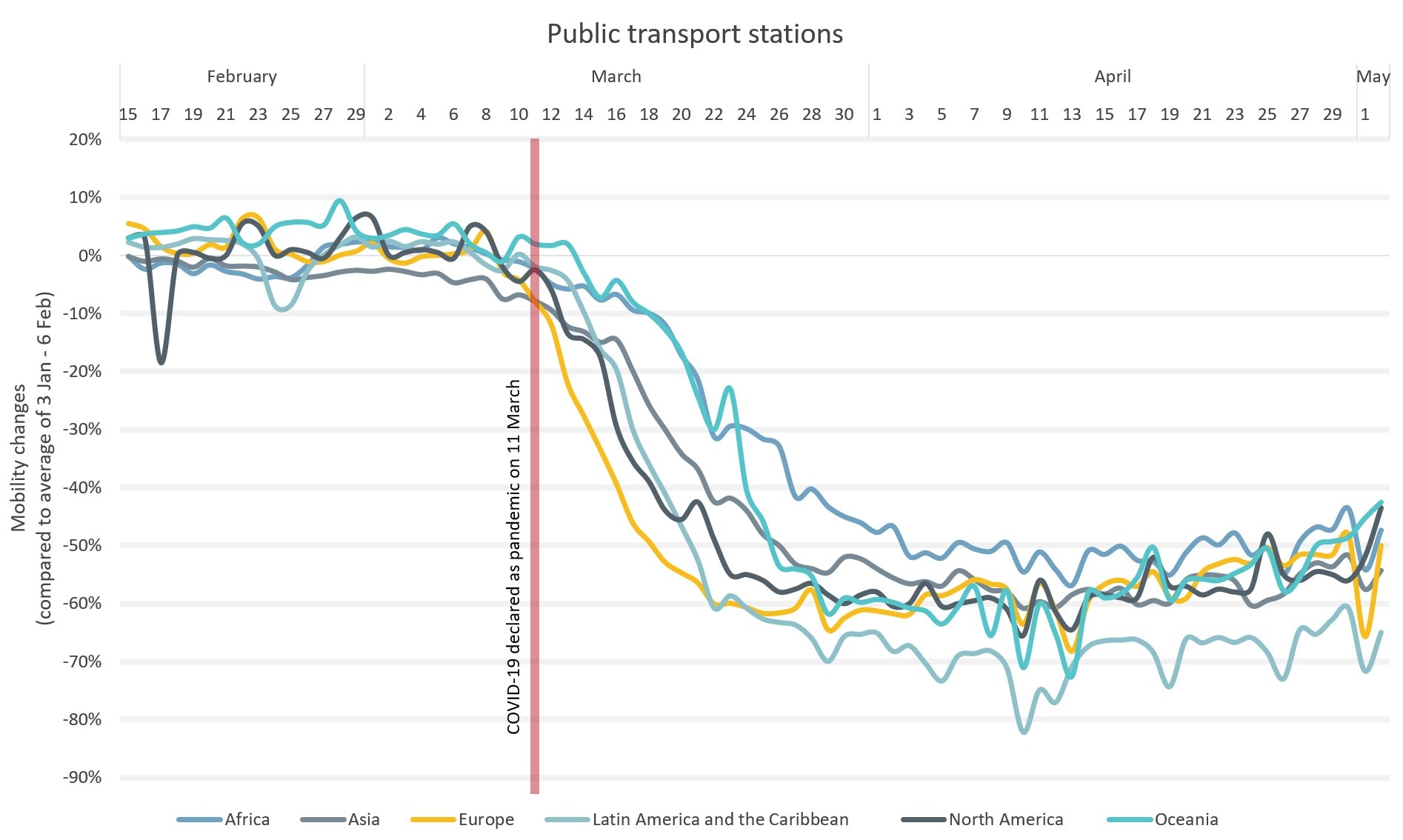[vc_row][vc_column][vc_column_text]
Impact of COVID-19 on Mobility
The COVID-19 outbreak was declared a global pandemic on 11 March 2020 by the World Health Organisation (WHO). Shortly after, United Nations Secretary General António Guterres described the pandemic as “a human crisis, with multifaceted threats” and “the greatest test that we have faced together since the formation of the United Nations.”
In recent weeks, global data showing how mobility is being affected by COVID-19 in different regions has emerged, primarily from Google and Apple through their map services data and location history data. This analysis examines such data sets to describe the early impacts of the pandemic on passenger mobility in urban environments. It looks at how regions and different income groups are affected, and seeks to provide a preliminary answer to the question of how COVID-19 is impacting urban mobility and transport modes.[/vc_column_text][vc_column_text]
Impacts of COVID-19 on global mobility
[/vc_column_text][/vc_column][/vc_row][vc_row][vc_column][vc_column_text]The analysis of mobility to the various destinations shows that regions and income groups are impacted differently: Latin America and the Caribbean (LAC) records the largest impact for the majority of aspects. Among income groups, high-income countries experience the biggest differences compared to the baseline. Exploring queries for transport modes across all regions, a reduction of 60 to nearly 80% compared to the baseline of 13 January 2020 for driving, public transport and walking can be identified. The decline started on 8 March 2020 and the biggest downtrend was reached in early April. Public transport has seen the largest decline, reaching a 76% reduction in April 2020 at its lowest point.
This early analysis outlines how passenger mobility trends in urban environments have been impacted from the first weeks of the global COVID-19 pandemic. It does not provide a complete picture of how passenger transport is being impacted. The data shows the impact but not the cause. Various reasons (e.g. number of registered infections and deaths, dates and extent of curfews, lockdowns, social distancing) influence mobility behavior and none of them can be directly extracted from this initial trends analysis.[/vc_column_text][vc_column_text]
Impacts of COVID-19 on mobility in Asia and Latin America and the Caribbean
This paper provides more detail and insights on the impact of COVID-19 on urban mobility in the Asia and LAC regions. Asia is the epicentre of the early stages of the COVID-19 outbreak. The overall mobility trend in Asia shows that the mobility changes happened less rapidly than in other regions. In a few cases, there is already a sign of recovery for a few Asian countries. Mobility to public transport stations has reached pre-COVID-19 levels in Mongolia and Korea. Vietnam is also very close to the baseline, after having very low levels in the first three weeks of April 2020. Countries such as Korea and Vietnam are currently often referred to as success stories in terms of their treatment of the COVID-19 pandemic.
LAC seems to encounter the largest impact in terms of percent changes in trips to major destinations. Mobility disruptions happened very quickly from the week of 16 March 2020, and levels have stayed more or less the same since then. Trips to public transport stations decreased significantly in every LAC country without any exception. The majority of countries have experienced a reduction between -60 and -80%.[/vc_column_text][vc_row_inner][vc_column_inner width=”1/3″][vc_single_image image=”3912″ img_size=”large” alignment=”center” style=”vc_box_shadow” onclick=”custom_link” link=”https://slocat.net/wp-content/uploads/2020/05/SLOCAT_2020_COVID-19-Mobility-Analysis.pdf”][/vc_column_inner][vc_column_inner width=”2/3″][vc_column_text]
However, this preliminary analysis confirms what can be observed in many cities around the world right now: The most visible impact is the very strong decline in the use of public transport. The percentage change of trips to public transport stations is the highest. For this specific impact and many others, the strongest impact can be recognised in LAC and in high-income countries. This preliminary analysis identifies that a few countries in Asia already see a tendency towards recovery of mobility use. However, only time will show how mobility and transport modes are going to evolve in the coming weeks and whether any of the so-far temporary trends will be carried forward.
The lessons learned out of this crisis must be harnessed to accelerate and consolidate sustainable, low carbon transport and mobility patterns embedded in a balanced implementation of the Avoid-Shift-Improve framework.
Download our preliminary analysis of regional trends on urban mobility due to COVID-19 here.[/vc_column_text][/vc_column_inner][/vc_row_inner][/vc_column][/vc_row][vc_row][vc_column][vc_column_text]
The analysis on COVID-19 impacts on mobility and transport modes was presented at the TUMI TV. You can view here the presentationmaterial which summarises key findings of the report.
For more information on activities around COVID-19, please visit our resource page here.
[/vc_column_text][/vc_column][/vc_row]
